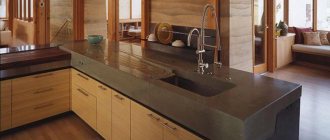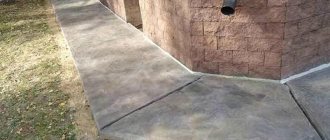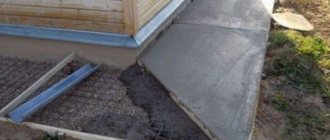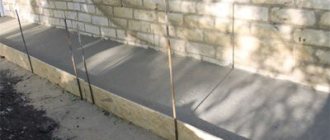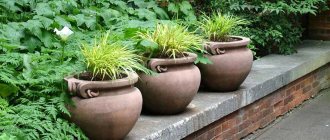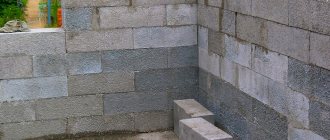In recent years, concrete furniture has become increasingly popular in modern interiors such as loft, hi-tech, and minimalism. Thanks to the peculiarities of the structure of the material and its original appearance, ordinary concrete tables or other elements become a real find, emphasizing the decor style and acting as one of the key accents in the design of the room.
The main advantage of concrete furniture is its uniqueness, because you can make an element with your own hands or by ordering it from a craftsman, but according to individual sketches and sizes. In this way, it is possible to implement the most unusual ideas, making concrete furniture the highlight of a classic or modern interior.
In terms of functionality and practicality, concrete furniture is in no way inferior to options made of plastic, wood, or analogues of wood material. The only difference, as a rule, is the large weight - the weight of concrete is several times greater than similar wood products, for example. However, concrete has many advantages, so it is rapidly conquering the furniture market not only as a decorative element, but also as part of the usual home furnishings.
Concrete furniture is most often used in the kitchen (these are tables and countertops), as well as in living rooms as coffee tables, cabinets, chests of drawers, etc. Some designers create accessories from concrete and other furniture elements. As a rule, products made from decorative concrete are created to order according to individual sketches; literally anything can be realized thanks to the plasticity and pliability of the material.
Decorative concrete can be of any color, shape, texture. The surface of the product can be glossy, matte, textured, structured. Gloss is achieved through grinding, fillers determine the type of structure of the material, texture is created by the surface of the mold for casting or subsequent processing of the hardened monolith. It is possible to perform cladding with ceramics, smalt, and inlay. Concrete lends itself well to painting and varnishing.
The main advantages of concrete furniture:
- Resistance to mechanical stress and loads.
- Resistance to any external negative factors - shocks, temperature changes, moisture, liquids, etc.
- High plasticity.
- Ease of use - if plastic furniture can be made only with special equipment, tools, knowledge and skills, then almost any craftsman can make a concrete table using available tools.
- Durability – many concrete products can last for decades.
- Low cost of raw materials and production.
- Environmental friendliness and safety of concrete for human health.
Some time ago, concrete furniture could be seen preferably in banks, cafes, and restaurants.
Today, such furniture is becoming increasingly popular for installation in residential premises due to functionality, originality, practicality, durability and reasonable cost.
What kind of concrete is used to make furniture?
The type of concrete used for furniture depends on how the product will be used - outside or indoors. As a rule, the base solution is a mixture of sand, cement grade M 400 (without additives), fine crushed stone, water (25% by weight of dry substances) and a special superplasticizer - a substance that gives the solid mixture more plasticity.
Use quality concrete.
In addition, this facilitates further work on processing the ready-made, hardened composition.
Decorative
To solve various design problems, the following can be added to the basic solution:
- pigments, preferably natural (for example, oxides of various metals);
- marble chips;
- stone filler;
- coil;
- water-repellent additives;
- additional elements for decoration.
Concrete furniture will become the highlight of the interior.
The use of various admixtures and fillers allows you to create unique pieces of concrete furniture, which become an excellent component of a modern design solution, decorate the interior, and make it original.
As a finishing material
Monochrome, “naked” interior is the trend for 2022. Concrete finishes work best for this style.
A great idea is to use large concrete planes to the maximum: walls, ceiling, self-leveling floor. If you leave the ceiling unfinished, the electrical connections will have to be done openly, and the room will immediately take on a brutal industrial look.
How concrete furniture is made
To make concrete furniture, you need to know the features of the casting process. First, decide on the form.
The shape of the product may vary.
To form the future product, use:
- old plywood;
- laminated chipboard;
- slats;
- laminate;
- boards and other durable materials with a good water-repellent surface.
To make formwork easier, the wooden frame - form - is covered with thick plastic film. Mesh or fabric is used for reinforcement.
Leave the solution to professionals.
While the solution is soft, to decorate the upper part of the product you can use pre-dried fruits or plant leaves, beautiful pebbles, coins - whatever you like.
Additional information: objects are placed carefully on the very bottom, glued so that the dense mass does not move them during spreading and hardening.
What tools are used for work
Making concrete furniture takes a lot of time, since there is no need to rush in such a “delicate” matter - everything needs to be done carefully and carefully. You can’t do without tools and special materials.
Prepare all tools and materials.
For the manufacture of concrete furniture the following are used:
- circular saw or jigsaw (for cutting formwork);
- mixer or special attachment for a hammer drill;
- wood drills and a screwdriver (for assembling the base of the structure);
- grinding machine for processing concrete surfaces (preferably with moisture protection);
- small tools: spatulas, tape measure, square, container for mixing the base solution and others.
Please note: the number of tools you need to use in your work and their purpose may vary. This depends on the complexity of the structure being manufactured.
Important! When working with a circular saw, jigsaw and grinder, it is important to follow safety rules.
To create accessories
Interior accessories deserve special mention. Due to the ease of production, their range is very diverse: from mobile phone holders to lamps, from watches to flower pots. The possibilities are limited only by flights of fancy.
Kawabanga! Forms for concrete stones
On the Internet you can find brilliant ideas for concrete accessories for home and garden and easily repeat them. Chinese manufacturers have caught on to the trend and are selling reusable molds for making concrete accessories in online stores.
Casting technology
How is concrete furniture made—more precisely, how is it cast? There are two main methods known: direct casting and reverse casting. In the first case, the formwork is assembled (on site), the top side of the mortar will be the front side in the future.
Concrete furniture has absorbed all the quality characteristics of concrete.
In the second case, the form is assembled, the filling is done separately: the bottom becomes the top in perspective. Backfilling allows for a smoother surface, which further reduces finishing time.
Mixing the solution and pouring: stages of work
How to make a base solution? Using a mixer, of course. The composition of “furniture” concrete is already known. It was discussed above.
Concrete furniture can be created independently.
- Knead the mass.
- The mold is filled using one of the casting methods from the edges to the center.
- To avoid cavities from air bubbles, tap the sides and bottom well.
- The top is covered with a thick film and left to dry. The time of the latter depends on the thickness of the mass, its volume: sometimes 4 hours are enough, and sometimes it takes several days.
- Remove the dried product from the frame (a spatula helps): first, carefully release the side parts, then the bottom.
- The product is trimmed and cleaned with a brush dipped in water.
- The resulting sample is well polished and the surfaces are treated with special means.
Make sure the material is dry and use a spatula carefully to avoid damaging the material.
How does processing work?
Concrete furniture should not only be durable, but also visually attractive. This is achieved through further processing. Irregularities and voids are covered with an acrylic-based sealant, then the composition is allowed to dry.
The first introductions of concrete into interior design began with pedestals.
The next stage is thorough sanding. You can process the surface manually, but this will take a lot of time. It is better to use a grinder or drill with special attachments.
Using a grinder, you can make not only straight cuts, but also curly ones.
- They begin to work with a coarse-grained, rough circle. Then they change it to those with a fine fraction - 50 and 100.
- Polishing is performed with a disc with an abrasiveness of 400 units and above. It is possible to use a suede or felt nozzle. To achieve a mirror-like surface, operate at minimum speed.
- Sometimes the polishing step is omitted: they immediately use an acrylic-based varnish or primer. Then dry the treated surface.
What are furniture legs made of?
Legs for concrete furniture can be made from various materials. The main thing is to provide reliable support.
The table legs may be original.
- Metal. These can be ready-made legs, store-bought, or made yourself. Metal and concrete go together perfectly. Shiny metal and a well-polished concrete surface are an interesting option that can complement a modern room design well.
- Tree. The use of wooden stable supports and concrete is one of the common combinations. Such furniture is suitable for both outdoor and indoor spaces. Legs of unusual shapes can be made from wood. In some bold design solutions, the support can hardly be called legs. Here everything depends on the imagination and taste of the author.
- Concrete. From this material you can make legs of square, rectangular and cylindrical shapes, with bends and fancy shapes. The main thing is to have a good shape for low tide, and the technology was discussed above.
The table top can be made of wood, and the table legs can be made of concrete.
How to decorate concrete furniture
There are many ways to decorate a concrete surface. This is a creative process.
Decorating concrete furniture is not difficult.
- The simplest option is to decorate with pigments, white or colored.
- Laying ceramic tiles. A very convenient way to refine a straight horizontal surface. Its advantage is that the long and tedious stage of grinding and polishing is practically unnecessary. The tile protects the surface well from dirt and moisture, is easy to clean, and retains its original appearance for a long time. Instead of ceramics, you can use mosaic and composite tiles.
- Various fillers: beads, shell rock, seed beads, coins, colored glass or stones (marble, granite). Let us repeat that first these objects must be “planted” with glue so that the composition does not collapse at the moment of pouring the concrete mixture.
- Wood inlay. Use of valuable wood species. Concerning this option, the opinions of connoisseurs of concrete furniture are not clear. Some believe that such a combination of materials is simply ideal, while others, on the contrary, see dissonance in it: wood “breathes”, and concrete is static.
Additional information: Wood may develop cracks over time.
There are a huge number of options for concrete furniture, it’s impossible to list everything: chairs, tables, stairs, benches, table tops and more. Such products are durable and easy to care for. But you probably can’t call them easy.
Obviously, making such furniture is an art. Originality and creativity are appropriate in this matter.
Cons of concrete countertops
Difficult care. The main disadvantage of concrete is its porous structure. Cleaning out dust and dirt from small pores is a difficult task. To solve this problem, the countertops are covered with a protective polymer layer. The composition fills the pores, which makes caring for the product easy.
How to cover a concrete countertop depends on the purpose of the furniture. For a desktop, you can use a marble impregnation, for a kitchen work surface - a polymer coating.
To give the tabletop a brutal look, they deliberately leave marks from the formwork.
They get dirty quickly. If you spill grape or orange juice on concrete, it will leave a stain. There are two reasons for this: the porous structure of the material and calcium in the composition. Calcium is destroyed by the action of acids, which are found in natural juices. If a spilled drink is not cleaned up immediately, a stain will remain.
Important. The polymer coating protects concrete from acids and other substances. If the countertop often acts as a platform for culinary experiments, then the coating must be periodically updated.
Chips and cracks remain. It is easier to leave a scratch on a concrete countertop than on a quartz agglomerate. In this regard, concrete is inferior to other artificial stones. This damages the protective layer. As a result, the pores become clogged with dust and dull spots appear along the scratch.
Sometimes scratches become the hallmark of furniture, which can be complemented with an Artichoke chandelier
To read more about the chandelier with the photo above, see the article “Light without glare: the secret of Poul Henningsen’s artichoke chandelier.”
Defects in concrete most often appear in the edge around the sink. These are the weak points of countertops. It is thin and therefore can crack easily. To avoid this, it is important to make high-quality reinforcement. Sometimes two layers of reinforcing mesh are laid along these places. From here we draw an important conclusion: you must approach the choice of a company that will make your countertop very responsibly.
An apron made from the same mixture will help complement the concrete countertop.
Wooden facades are a suitable companion for a concrete island
